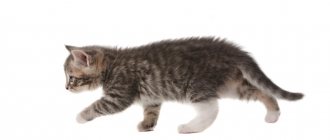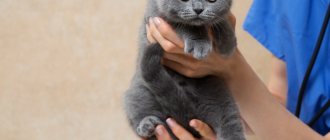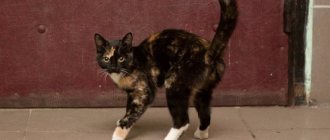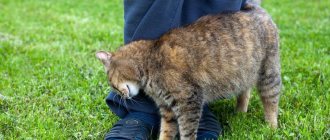Cats 73017
Childbirth is quite stressful for cats, as it is for absolutely any woman giving birth. Often, cat psychology, already poorly understood by people, changes significantly after the birth of offspring. You can often observe how a pet bites its babies, hits them with its hind legs or drags them by the scruff of the neck, while the kittens squeak.
The owners, alarmed by this behavior of their pet, begin to sound the alarm. However, not every mother cat nibbling on her litter is a danger signal. In this article we will try to understand when the behavior of a new mother is within the normal range, and when it is worth worrying about.
Bites as a method of raising offspring
A cat who has become a mother faces a difficult task: she needs to teach her litter everything she knows in the shortest possible time. This is required so that the kittens are ready for independent living. Moreover, in the wild, such activities would ensure their survival. At the same time, cats have much less time at their disposal than people have to raise their children.
You don't have to worry if your pet bites the kittens without leaving marks on their skins. As a rule, educational biting lasts until the baby makes a loud cry. With his voice, he lets his mother know that he understands everything, and, satisfied with this signal, she lets him go.
Methods to calm a cat
- You need to leave an irritated animal alone - let it come to its senses and calm down.
- When another animal appears in the house, temporarily protect the cat from contact until it gets used to the presence of a stranger.
- He begins to hiss at the stranger - give the four-legged owner of the territory something associated with this new neighbor - let him sniff and get acquainted with the smell.
- The best behavior for an owner when a cat hisses is to ignore the hissing and not pay attention to it.
Is it possible and how to prevent a cat from hissing?
If a cat hisses because of its character and breed, then nothing can be done. But, if the reason is different, external, then the owner simply needs to remove it. And if you can’t solve the problem with your cat on your own, there are specialists you can turn to for help.
Calm down or protect from danger
The psychology of the cat family is radically different from that of humans, and yet, in some ways we are similar. These animals, just like people, have their own methods of raising and protecting babies from danger.
Where a human mother would slap a naughty fidget on the butt, a cat mother will in the same way tell her baby how not to behave by biting the scruff of the neck. She can punish the kitten if it gets too excited and runs around, ceasing to notice everything around it. And also if the baby, being in a playful mood, climbs up to her, and in the meantime she tries to take a nap and replenish her strength.
A cat is capable of biting the skin of kittens that are trying to get out of the nest if she thinks that it is too early for them to do this. She will definitely claw her by the scruff of the neck or even hiss threateningly, not letting her onto the balcony, which, in her opinion, can be dangerous for furry fidgets.
You don’t have to worry if you notice how the mother stands over the baby and then takes his scruff in her mouth, then lets go. There is a high probability that at this moment she is not trying to harm him, but, on the contrary, wants to move him to a safe place. She just can't do it for some reason. Probably, the pet cannot figure out how best to lift it so as not to harm it. This sometimes happens, however, after several attempts, as a rule, the cat copes with the task.
How to understand a pet
To understand your pet, you need to love it and watch it. And then it won’t be difficult to translate her hissing into human language.
If a cat has huddled in a corner, hisses, and has its ears flattened, it is most likely scared. The animal is looking for a safe corner where it can hide. The fear will go away on its own, you need to leave the pet alone
Excessive attention can cause even greater panic and then aggression.
Is the cat in a high stance, holding one paw raised and hissing, are its ears not flattened? This is a signal that the cat is now going to attack the one he has chosen as the target of the attack. It's better to move away from him.
A cat's hiss can be difficult to explain. There is no danger, the owner strokes his pet, and in response there is hissing and aggression. What should you think about? Perhaps the animal is sick, and touching or stroking causes even greater pain
Alternatively, the cat is in a bad mood, she is tired, and human attention seems intrusive to her.
What can confirm the presence of the disease? This is apathy, lack of appetite, change in normal behavior. You shouldn’t wait to see how it all ends; it’s not difficult to take your pet to the veterinary clinic to find out the problem.
The Art of Hunting
Don’t let it come as a surprise to you when your pet begins to teach her offspring to hunt. At the beginning of classes it will look something like this: the mother cat firmly grabs the kitten with her front paws and beats on him with her hind paws. At the same time, she alternates between biting and licking him. In addition, it can purr loudly, encouraging it to learn.
At the initial stage of training in the art of hunting, the cat demonstrates with its kittens how to properly capture and subdue the prey. In addition, the ability to suppress will be needed by the young when they grow up and begin to defend their rights to territory and dominance. And believe me, in a couple of weeks you will already be watching kids practicing these techniques on each other.
When the litter grows a little more and begins to crawl out of the shelter, a slightly different picture will open before you. In addition to the training activities described above, demonstration hunting jumps and pursuit will be added. Mommy, by personal example, will show the children how to sneak, wait and suddenly jump on the victim. Everything will remain the same with the squeak: if you meow, you understand. As before, the young animals will continue to practice the techniques both among themselves and on the mother.
Fear as a reason for growling
Hissing and growling associated with fear appears due to insufficient attention to the kitten. If the kitten rarely had contact with people, did not receive due attention from them, or even suffered insults or even beatings from them, then fear of people will accompany an already adult cat
To understand that it was fear that caused the growling, pay attention to the following factors:
- a cat can rush at its owners in the presence of a certain stimulus, real or imaginary;
- if a pet is “cornered”, it hisses and growls much more intensely;
- aggression is accompanied by appropriate warning postures;
- the pet can connect its paw swings to the growl;
- when the situation comes to its logical end, the animal begins to relieve stress, for example, by licking the fur.
You cannot punish a cat for such behavior, since with such tactics it will always expect bad things from a person.
Rejection of foreign odor
In the case where a cat bites its offspring, and at the same time was previously picked up on the street or has access there for walks, this is a very bad sign. The fact is that such animals always remain semi-wild and their natural instincts are more acute than those of fully domesticated pets. Here, the reason for aggression towards one’s own offspring can be a foreign smell on the kittens. Unlike people, who recognize others visually, animals are identified using smell. Do not touch the kittens while the mother cat is nursing them, otherwise she may abandon them completely.
When cats hiss at kittens
Watching a cat hissing at kittens, you can notice that often its visible aggression in this case is a kind of lesson. It is not uncommon for babies to be trained in the form of outwardly aggressive play, in which mother and kittens mutually attack each other. In this way, babies gain the skills they need in the future to defend themselves and provide food for themselves.
© shutterstock
When playing, the cat growls, hisses and looks very intimidating, but her aggression is not directed against the kittens, she tries to recreate possible life situations. You should not interfere with their game. If you try to take the cub, the mother may hiss at you. This defense of the kittens by hissing is her natural reaction in the current situation.
Disease
There are times when a pet suddenly begins to show excessive aggression both towards its own babies and towards its owners. It is not uncommon for cats to develop eclampsia after giving birth, and this can be a reason for sudden hostility.
Eclampsia is a disease that should only be diagnosed by a specialist. It is not recommended to make a diagnosis yourself, because the cause of aggressive behavior may be simple fatigue or pain in the mammary glands (mastopathy). And yet, given that this disease occurs quite often, let's talk about it in more detail.
How to understand a pet
To understand your pet, you need to love it and watch it. And then it won’t be difficult to translate her hissing into human language.
If a cat has huddled in a corner, hisses, and has its ears flattened, it is most likely scared. The animal is looking for a safe corner where it can hide. The fear will go away on its own, you need to leave the pet alone
Excessive attention can cause even greater panic and then aggression.
Is the cat in a high stance, holding one paw raised and hissing, are its ears not flattened? This is a signal that the cat is now going to attack the one he has chosen as the target of the attack. It's better to move away from him.
A cat's hiss can be difficult to explain. There is no danger, the owner strokes his pet, and in response there is hissing and aggression. What should you think about? Perhaps the animal is sick, and touching or stroking causes even greater pain
Alternatively, the cat is in a bad mood, she is tired, and human attention seems intrusive to her.
What can confirm the presence of the disease? This is apathy, lack of appetite, change in normal behavior. You shouldn’t wait to see how it all ends; it’s not difficult to take your pet to the veterinary clinic to find out the problem.
Eclampsia in a cat: what are the signs and what to do?
Eclampsia (aka milk fever) is provoked by hypocalcemia - a disorder of calcium metabolism in the body, in which it begins to be sorely lacking. Milk fever usually develops in the first 2–3 weeks after lambing. This is due to the active leaching of calcium from the blood, due to the fact that it is involved in the formation of milk. Most common in mothers with multiple births.
Behavioral signals of developing eclampsia:
- Increased excitability and anxiety or lethargy and complete apathy;
- Aggression accompanied by lack of recognition of offspring and owners;
- Refusal to sit with own kittens;
- Avoidance of droppings feeding and biting, leaving marks on their skins;
- Frequently moving babies from place to place.
Physical signs of milk fever:
- Pointed muzzle with stretched skin and exposed fangs;
- Rapid breathing;
- Pale mucous membranes;
- Movements become abrupt;
- The animal has difficulty rearranging its “stiff” hind legs due to muscle spasms;
- Convulsions (intensity depends on the severity of the disease);
- Increased body temperature;
- Shiver;
- The pet often falls on its side;
- Uncontrollable salivation appears.
In a cat with eclampsia, the temperature rises to +41 °C. Carbon dioxide accumulates in the body, making it difficult for the animal to breathe. The pH in the blood increases and the calcium level decreases.
Milk fever is not so much dangerous for others as it is for a sick pet. If help is not provided in time, death from hyperthermia - due to depressed breathing and brain damage - will occur 12 hours after the onset of the attack.
If your pet has an acute attack of eclampsia, call your veterinarian immediately. Sometimes time passes by minutes, especially when an attack is not detected immediately, the doctor may simply not have time. It is in this case that, while waiting for the doctor, you will need to provide first aid to your pet yourself.
In case of an acute attack of eclampsia, it is necessary to inject subcutaneously:
- Fospasim or any other sedative - 1 ml;
- Gamavit - 1 ml;
- Calcium borgluconate (heated to 39°) - 2-3 ml at intervals of 45 minutes until symptoms disappear;
- No-shpa - 0.3 ml;
- Prednisolone - 0.5 ml.
After injections, place the cat in a dark, noise-free room until the attack stops. To prevent relapse, calcium (1 ml) will need to be injected 2 times a day for about two more weeks.
As the disease progresses, the kittens are taken from the mother cat and fed with an artificial formula, then returned. If the babies are more than 3 weeks old, introduce complementary foods; formula alone will no longer be enough for them.
Certain cats are more prone to milk fever than others. If your pet is predisposed to eclampsia - if such an attack has occurred at least once - it is necessary to pay special attention to her after lambing. In addition, it is worth worrying about the issue of prevention in advance by consulting with a veterinarian. As a rule, a diet with a high calcium content is prescribed. Cats at risk always have a fairly high chance of relapse. For such pets, the intervals between lambings should be as long as possible.
Why does a cat not let a cat near her during mating?
home
You really want kittens from your cat, and now she is in heat. It's time to take her to the cat. But, while visiting, instead of accepting the cat’s advances, the cat became extremely aggressive... Why? The most common reason is incorrectly chosen days for mating - i.e. the cat is just not ready yet. Usually the cat is allowed in to the cat on the 2-3rd day of estrus.
Most owners take their cat to the cat's territory, and sometimes this is very stressful for the cat, and this leads to aggression towards everyone and everything that moves. To somehow calm your cat, you can use a diffuser or Feliway spray, or give her Stop-Stress herbal drops. It is necessary to leave the animals alone for 2-3 days in an isolated room, where there is a tray and food with water. If the cat is experienced and persistent, then the mating will take place. But such a cat can be very intimidating to a young cat.
Another reason could be a health problem with the cat, so she should be examined by a veterinarian before breeding. For example, if a cat has inflamed anal glands, then during mating it becomes painful for her, and she rushes at the cat. Perhaps the cat experiences pain during estrus, which also leads to aggression on the part of the animal.
It happens that a cat simply doesn’t like a particular cat, but later she mates with others without any problems. But there are cats who never let cats near them. This indicates an incorrectly formed sexual instinct, which may be the result of problems with the ovaries or uterus.
For successful mating, animal owners and experienced felinologists recommend a variety of methods: pour a solution into a bowl or scatter mint herb; leave the cat in a cage or carrier so that it can get used to the cat and communicate with it for a couple of days; periodically take the cat out of the room “for a walk”; for an aggressive cat to look for an equally aggressive groom who will show “who’s boss”; press the cat to the floor yourself during mating; give the cat a tablespoon of Cahors (wine); injections of a drug that induce ovulation...
Bites as a health check and detection of weak litters
A cat bites kittens not only when raising them or in an attack of some disease. Remember the main law of animals: “survival of the fittest”? So, animals, unlike people, do not care for young animals with congenital diseases; on the contrary, they can behave very aggressively towards sick litters.
Cats, although domesticated, still have innate instincts that they cannot escape. Sick kittens will be detected by the pet just by biting. As already mentioned, by biting lightly, the cat checks the reflexes of the offspring, and if something does not suit her, she will abandon the sick baby. Be careful, there is a high probability that the mother will try to kill the baby who is unfit for life.
If you notice that one of the kittens stands out from the general heap of brothers or the mother cat is more aggressive towards one of them than towards the rest of the litter - sound the alarm, the kitten is sick. If you are going to keep him alive, take him to the vet. As a rule, after the sick baby is cured, the cat accepts him back and no longer shows hostility towards him.
It is better not to wait for your pet to attack the kittens, but to periodically examine them yourself, showing them to the doctor if necessary. The health status of furry babies can be determined “with the naked eye” by a number of signs.
Healthy kitten:
- It looks round and knocked down;
- Skin pink;
- Warm to the touch;
- If you gather the skin into a fold and let it go, it will straighten out immediately;
- On the palm of your hand, the baby stretches out and swings energetically.
Sick kitten:
- Lack of energy, barely moves, constantly lethargic;
- Hyperactive, but exhausted, falls asleep away from his brothers and mother;
- He sleeps with his limbs spread to the sides, his head tilted to the side;
- Noticeably cool to the touch;
- Skin has a bluish tint;
- When trying to eat, the nipple spits out;
- While awake, he continuously screams pitifully.
If, according to your observations, all the kittens are healthy, but the cat still shows obvious aggression towards one (or several) of them, she probably does not have enough milk. She may try to compensate for the lack of milk by weaning someone off the breast so that others can get enough. As a rule, the weakest descendant, even if not the sick one, is selected for this purpose.
Video: cat raising kitten
Causes of aggressive behavior
In fact, there are many reasons to attack or scratch the owner. If a child cuddles and nurses a cat all day long, it is not surprising that the pet will begin to snarl and hiss. Before moving on to solutions, let's look at the roots of the problem.
Character of the breed
Not all cat breeds are equally friendly. Among cats there are people with difficult characters. For example, Siamese, Thai, Russian blue cats. A difficult character makes him jealous of toys, sleeping place, and selective in his contacts with strangers. What can I say, even family members get it from the fuzzy fussy ones.
Excessive importunity, excessive attention, the desire to stroke or sit on your lap often causes the cat to respond aggressively. Favorite toys or litter tray should not be moved and left in the pet's care
At best, the cat will indicate dissatisfaction by hissing; at worst, it will attack the owner.
Protection of offspring
In the first weeks after giving birth, the cat jealously guards the kittens. It is almost impossible to separate your pet from newborns, and any gesture or loud noise can be considered a safety hazard. A cat in the postpartum period is extremely suspicious of uninvited guests and other animals.
But such aggression, caused by maternal instinct, will soon subside. As soon as the kittens open their eyes and begin to walk more or less confidently, the influence of the mother cat weakens. You can fearlessly approach her and even pick up the cubs.
Street past
Some owners bring home cats or kittens straight from the street. But there is no certainty that the previous owners (if any) treated the pets well. Perhaps they ignored him or beat him. If this happened in childhood, the kitten might be left with the idea that all people are cruel and evil.
In addition, only the strongest cats get food on the street. Therefore, it is quite difficult to predict the behavior of a pet even after many years of domestic life.
Wrong games
Many people have a question: why does a kitten attack its legs or bite its hand? The answer lies in playing with your pet incorrectly.
Playing with your kitten is a great idea, but don't overuse open-handed play. The pet bites funny and it doesn’t hurt at all, but with age, when his teeth and claws get stronger, he can seriously scratch him. Simply because he’s used to it and it’s possible. The situation is similar when using other parts of the body when playing with a kitten.
Interference in the struggle for territory, food
The point is relevant for owners of private houses and summer cottages. Showdowns between your pet and the local cat population will be commonplace. Often it will come to fights for authority, females and territory.
If the owner unexpectedly intervenes in the cats' confrontation, the pet may respond aggressively. At best, the owner will scare away the fighters and they will run away hissing and screaming. At worst, unite with the offender and make the person extreme.
The situation is similar with food. Of course, cats are not dogs, but they will defend a bloody piece of meat or a saucer of milk to the last. Hissing and scratching can be costly for the troublemaker.
Fear
There can be many reasons for fear, from unfamiliar surroundings and people to pain. Usually there are several degrees from mild to severe. The first is characterized by the careful actions of the animal, uniform exploration and sniffing of the room, people or other animals. In general, mild fear stimulates the animal to survive.
In severe forms, the animal tries to hide, growls or uses its claws. In the most extreme case, the pet loses control of itself and poses a danger to others. Leave the room immediately, closing the door until the animal calms down.
Pain is also often the cause of aggression. Sometimes the owner does not notice the pet’s apathy for a long time; the pet hides in a secluded place and licks its wounds
When the owner pays attention to the pet, it growls and snarls, not letting it get close. Cats react poorly when their tail, belly or armpits are touched.
Can cats growl?
Many owners of exquisite cat breeds (for example,) do not believe that their creature can growl like some kind of wild animal. However, time passes, and one fine day, the owners still hear this animal roar from the lips of their cute cat. It's not surprising.
Whatever breed your pet belongs to, its ancestors are wild cats, who expressed their emotions in such a primitive language of communication as growling.
As a rule, this happened in situations where the animal needed to defend territory, protect offspring or a female, and, of course, scare away uninvited guests from its prey. Then the wild cats took a threatening pose and began to growl menacingly, speaking in their own language that they were in charge here, and everyone else had better just get out of the way.
Ah, now let's look at the most common causes of growling in domestic cats.
Ownership instinct
Resentment
If you have offended a cat, and she harbors a grudge against you, then any approach to her and any attempt by you to pet her will be met with a growl. In this case, you should not force your affection on the cat; it is better to try to make peace with it, using all the methods available to you and human cunning. Appease the pussy, treat her with a cat treat, show her how sorry you are for not respecting her with your attention. The cat's heart will definitely melt from such attention, and she will stop growling at you.
Warning
Cat growls at kittens
Sometimes cat owners complain that the cat, instead of being a caring mother, begins to growl at her kittens. In this case, it is not worth interfering with animals. A cat can raise a kitten in this way, punish it or show it who is boss in the cat family. It is better to observe the situation from the outside. you can find out why a cat might eat her kittens.











